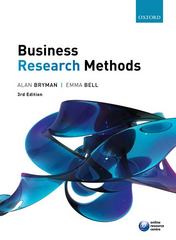Answered step by step
Verified Expert Solution
Question
1 Approved Answer
Questions Q 1 . Using a trial and error approach, propose a production schedule for meeting the first week's demand for the five parts. Q
Questions
Q Using a trial and error approach, propose a production schedule for meeting the first week's demand for the five parts.
Q Develop a linear programming model to determine the optimum production schedule that minimizes the total machine hours of overtime needed to meet the weekly customer demand. Assume that the weekend preventive maintenance effectively resets the machines so that new setups are required to start production each week. Note that in this scenario any remaining production time that is insufficient to setup for a new part, is simply lost. This is a consequence of the maintenance process and the company policy of not carrying any inventory between weeks.
Q Whenever overtime production needs to be scheduled, the traditional practice has been to schedule it on machines that are most efficient for the part being produced. This has often led to uneven overtime
assignment in the sense that long hours of overtimes are scheduled on one or two machines while other
machines remained idle. While this resulted in lower total overtime paid to production personnel, it of
ten resulted in higher overall costs because of the overtime costs of the required support personnel such
as administrative assistants, electricians, material handlers and quality control technicians. Their presence
is necessary as long as production is in process, irrespective of the number of machines operating. Tom
wondered if it would be more economical to schedule production on more machines over the weekend and
minimize the total duration for which overtime production takes place. Modify your model to minimize the
total duration of overtime production Le maximum of the overtimes on all machines rather than the sum
of overtimes on all machines? Compare the optimal production schedule obtained with the new objective with
that for question and then discuss the nature of changes in the optimal solution.
Q Modify your model to minimize the total cost of overtime for production and support personnel, assuming
that the cost of scheduling overtime on each machine is $ per hour and the cost of support personnel during
overtime is $ per hour.
Q At present, the weekend preventive maintenance effectively resets the machines so that a new setup is
required to start each week's production question Tom and the maintenance supervisor developed a method
by which the routine maintenance can be performed without disturbing its setup. Modify your model to take
advantage of the initial setup on a machine at the beginning of a week. Assume that machines through are
setup to produce parts and respectively, at the start of week
Q The new maintenance method can also result in additional savings it production on any machine can be sequenced such that the machine ends a week's production setup for a part and starts the following week producing the same item. Extend your model to schedule production for two weeks at a time, FDC is strongly committed to being responsive to customer's needs and attempts to satisfy all demand by using overtime when necessary. On some occasions, weekly production requirements exceeded FDCs capacity, even with maximum overtime. Under these conditions, FDC believes that it is critical that these shortfalls are recognized early in the process and communicated to the customer as soon as possible with a clear indication of the likely delays in delivery. Tom noticed that during some weeks, while overtime is scheduled on some machines, other machines were not fully utilized during the regular time. Tom also noticed that in some weeks, more than one machine needed to be setup for some of the parts to meet the weekly demand. He wondered if these inefficiencies could be reduced or eliminated if FDC relaxes their longterm policy of not maintaining finished goods inventory. In that case, any excess capacity on a machine in a week can be used to produce additional units to meet the following week's demand. This may also lead to a reduction in the number of machines that need to be setup for a given part during a week. Use the delivery schedule for week in Table as the new demand in week and assume that a penalty cost of $ per week is imposed for each unit not delivered on time. Assume that the cost of carrying inventory is $ per unit per week. Modify your twoweek scheduling model to permit inventory to be carried between two weeks and generate information on potential shortfalls.
Please answer above all questions.. Thank you!

Step by Step Solution
There are 3 Steps involved in it
Step: 1

Get Instant Access to Expert-Tailored Solutions
See step-by-step solutions with expert insights and AI powered tools for academic success
Step: 2

Step: 3

Ace Your Homework with AI
Get the answers you need in no time with our AI-driven, step-by-step assistance
Get Started


